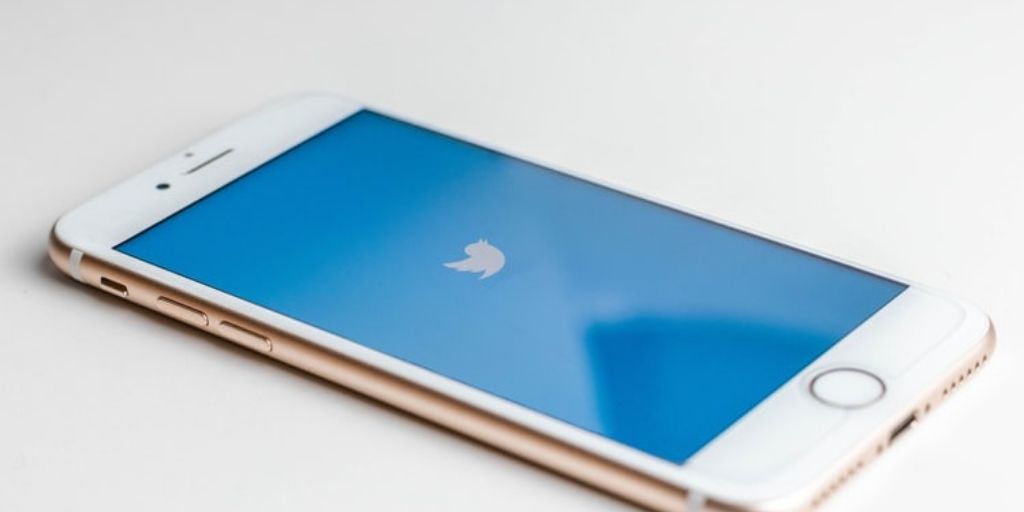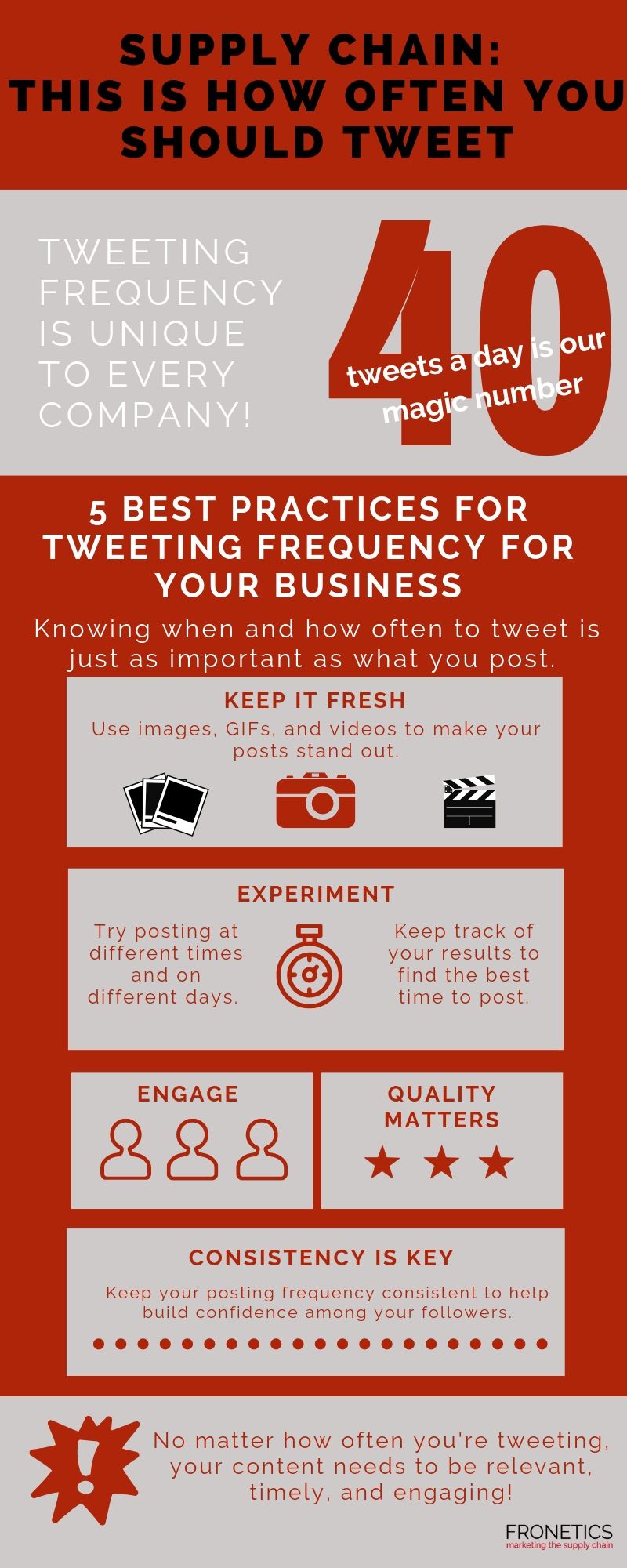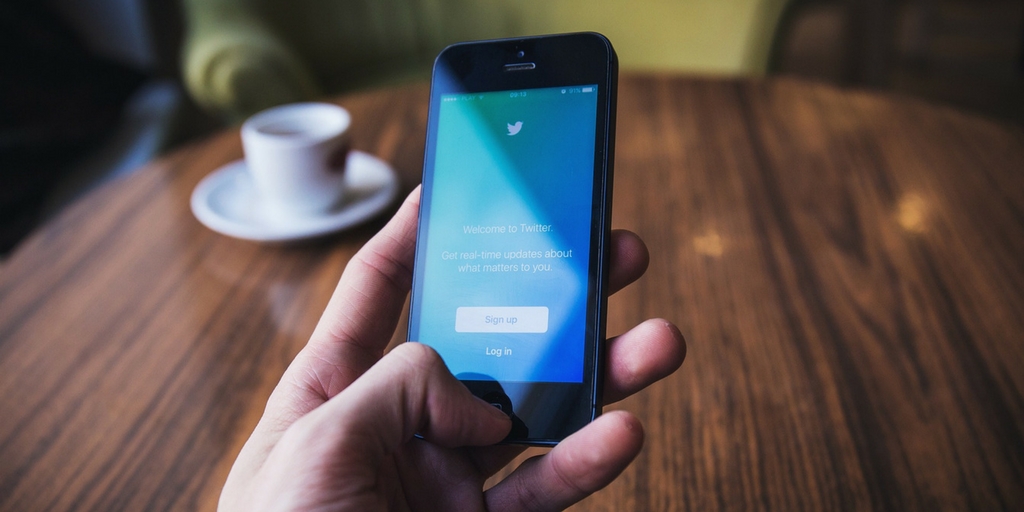
by Fronetics | Jul 10, 2019 | Blog, Content Marketing, Current Events, Marketing, Social Media
Knowing when and how often to tweet is just as important what you post. Here’s how often your business should be tweeting.
Highlights:
- Be consistent with your tweeting frequency, while keeping content fresh.
- To determine how often to tweet for your business, experiment with different posting frequencies, and use analytics tools to track your results.
- As with any digital marketing endeavor, quality is more important than quantity.
It’s a perennial question we get from our clients: how often should business be posting on social media? The answer varies widely from platform to platform, and the answer for how often to tweet has proved a controversial one.
Back in 2016, in response to a Socialbakers study that suggested that posting to Twitter three times a day is an ideal frequency for brands, Fronetics conducted a study of our own. We determined that for our business, tweeting around 40 times a day is optimal.
What these radically divergent results demonstrate is that the answer to how often to tweet is not a simple one. While the bottom line is that optimal tweeting frequency is unique to every brand, there are 5 best practices your business should be aware of.
5 best practices concerning how often to tweet for your business

(Made with Canva)
1) Consistency is key
Whether you’re tweeting once a day, or a hundred, being consistent about posting frequency will serve you best. Keeping your posting frequency relatively consistent lets your followers gain confidence that you will set and expectation and meet it. As social media algorithms become less friendly to businesses, it’s all the more important that you bring your followers to you.
2) Keep it fresh
It’s important to point out that consistency is key only when it comes to how often to tweet – not the content you’re publishing. Particularly on Twitter, varying your content is the best way to keep your audience engaged. Use images, GIFs, and videos to make your posts stand out, or ask questions to promote conversation and engage your followers.
3) Experiment
When it comes to how often to tweet for your business, you’ll find all kinds of divergent ready-made answers. But the truth is, there’s no magic number. Your business or your marketing partner needs to determine what works for your unique brand and audience. The best way to do this is to experiment with posting at different times and keep track of your results. In addition to Twitter’s internal analytics, these five tools can help you track and evaluate the results of your experiment.
4) Engage
As with any social media platform, publishing content shouldn’t be your only focus. Engaging with your followers, from comments to retweets, is crucial for generating an active and loyal audience.
In addition, using social media to interact with your audience can help inform your decisions about how often to tweet. When are your followers most active? What kind of content do they want to see from you? Having a conversation with your followers is one of the best ways you can answer this question.
5) Quality matters
There’s no amount of posting frequency that makes up for posting poor quality content. If your content is bad, you’d likely be better off not posting at all. Publishing content that doesn’t interest your audience will lose you followers and leads. No matter how often you’re tweeting, your content needs to be relevant, timely, and engaging.
Related posts:


by Fronetics | Sep 20, 2017 | Blog, Content Marketing, Marketing, Social Media
When it comes to social media platforms like Facebook and LinkedIn, post once a day to improve engagement and visibility.
There has been endless research about the sweet spot for posting frequency to social media sites. The results all point to the same conclusion: there is no one-size-fits-all answer. You have to distribute content consistently over time, at the right time and in the right place for your business.
That being said, we at Fronetics do have some informed, data-based opinions about posting frequency for certain social media platforms. For example, we’ve written extensively about our Twitter experiment, in which we found that tweeting 40 times per day works best for us and most of our clients.
But for other platforms, we find that more doesn’t equal better. In fact, it can often equal worse. Let me explain why.
Why you should be posting less on Facebook and LinkedIn
We strongly believe that most B2B companies should post no more than one time per day on Facebook and LinkedIn. We also suggest that businesses only post during the workweek on LinkedIn. That is because of the way people use these networks — and because of how the platforms’ algorithms value content.
Firstly, though we’d like for prospects to be thinking of our brands constantly, they don’t. And they don’t want to. Think of that one family member that inundates your newsfeeds with posts. Though you might have liked to see a photo from that person now and again, the inappropriate posting frequency causes you to think negatively about each post you see.
And you are a business, not a family member. When you post too frequently, your business loses credibility, and followers view your posts as spam. Even on LinkedIn, which is a network for professional content, over-posting leads to disengagement.
Remember that the lifespan of a Facebook post is about 5 hours, and with LinkedIn, it’s even longer. (One of the first posts on my feed right now is from 5 days ago.) So you don’t need to provide a constant stream of content to get your audience’s attention. Your focus should be distributing the most relevant, interesting content you can. Which is related to the second reason we recommend posting only once a day on these networks: algorithms.
Facebook estimates that each user’s newsfeed must filter 1,500 possible stories from friends and pages every day. Ain’t nobody got time for that! So Facebook, like LinkedIn and other networks, uses an algorithm to determine the content you’d like to see most, based on feedback you provide. That feedback comes from actions you take: hiding posts, liking and sharing posts, and commenting, for example. It even considers how often your friends and the world at large engage with a post. This helps the algorithm filter down to the approximately 300 stories per day on your newsfeed.
All this means that the more engagement you can get on your posts, the more likely they are to be one of the 300 (in other words, appear in the newsfeeds of your followers). The more often you post, the less likely you are to foster engagement, diluting your chances of success and visibility.
So how can you increase likes and comments on your Facebook and LinkedIn posts?
Here are 3 tips for improving your posts to foster engagement.
1) Be strategic.
Instead of sharing content or publishing on an ad hoc basis, create a strategy and schedule to manage posting on social media. Work ahead of time so that you can evaluate what you’re posting from a 10,000-foot perspective. But be flexible enough so that you can always sub out scheduled content for breaking news or content related to current events when it makes sense.
2) Craft better posts.
Spend less time crafting a lot of posts, and more time producing quality content your audience will value. I recently talked about the 10x content rule. If your content is better than everything else that’s out there, people will gravitate to it.
3) Be smart about when.
When you’re only posting once a day, it’s important to make every post count. Use built-in and third-party analytics tools to determine when your followers are using these platforms. Schedule your posts to publish just before the greatest time of active use.
At the end of the day, there’s a fine line between annoying your social followers and remaining top of mind. Maintaining a dynamic and fluid posting strategy will ensure that your social efforts drive followers to action, rather than drive them away.
Related posts:


by Fronetics | Mar 14, 2017 | Blog, Content Marketing, Marketing, Social Media, Strategy
Keep these best practices in mind when determining how often to post to social media.
Creating valuable, relevant content in a strategic and consistent manner creates demand for your products and services and drives profitable customer action. But as BuzzFeed’s Jonathan Perelman said, “Content is king, but distribution is queen and she wears the pants.”
It’s not enough to just create interesting and pertinent content; you have to put it out there to reach your target audience. Moreover, the content needs to be delivered consistently over time, at the right time, and in the right place.
With social media networks changing daily, it’s hard to keep up with where to distribute content, much less how often. Countless studies have attempted to solve the social-media-frequency equation. And while audiences vary across industries, best practices give us some general guidelines.
Here’s our assessment of social media posting frequency.
Twitter: 40 per day*
*Big caveat here: 40 tweets per day is what we’ve found works for us and most of our clients. Let me explain.
Socialbakers suggests that posting to Twitter three times per day is the ideal frequency for brands. Buffer posts to Twitter 14 times per day. Fronetics happens to tweet 40 times per day. So last spring, after seeing the Socialbakers and Buffer stats, we conducted a month-long experiment to see how dropping our posting frequency closer to their benchmarks would affect our engagement.
As we’ve written about before, it wasn’t pretty. We confirmed that our engagement, web traffic, lead generation, and other key performance indicators are at optimal levels when we tweet 40 times per day.
Your company, or your marketing partner, should conduct due diligence and determine what the right frequency is for your business. Yes, you may realize a significant decline in engagement in ROI during your experiment. On the other hand, you may realize an increase in engagement and ROI — captured with lower output in terms of time and resources.
Facebook: 1 per day
Most companies find that posting 1 time per day is their sweet spot for most social media networks. Facebook is no exception: The network’s algorithm values quality over quantity, so the more engaged your followers are with your content, the more likely they are to see your posts. This also means that posting content that does not facilitate engagement can actually decrease the likelihood that followers will see your posts.
One sure way to encourage disengagement is by overwhelming your audience. We all have that friend or company we follow that posts too much — don’t be like that person.
Remember that the lifespan of a Facebook post (about 5 hours) is significantly longer than that of a tweet. So you don’t need to provide a constant stream of content to get your audience’s attention. Your focus should be distributing the most relevant, interesting content you can, at a time when most of your audience will be on Facebook.
Instagram: 1-2 per day
There’s an unwritten rule among Instagramers that a user shouldn’t post more than once per day. We generally agree for the same reason we don’t think brands should post more than once a day to Facebook: Don’t overwhelm your audience because the lifespan of your posts is pretty long. In fact, a Union Metrics study found that many Instagram posts continue to receive engagement for days — even weeks — after posting.
Most brands end up posting 11-20 posts per month. If you focus on compelling images with strategic messages, that’s probably a good benchmark to stick with. It’s important to note, however, that another Union Metrics study suggests posting consistency is more important than frequency. Again, taking the time to test the Instagram posting frequency that works best for your business is a worthwhile endeavor.
LinkedIn: 1 per day
A more formal and technical social media network, consider LinkedIn a platform for business-related content. Don’t post here more than once per day — and consider posting only during the workweek. Many professionals don’t check LinkedIn on the weekends, and your content could easily be missed.
Buffer reports that posting 20 times per month (once a workday) allows companies to reach 60% of their audience. To provide the most value for your LinkedIn followers, content should be less promotional and more heavily focused on industry-wide trends and insights.
At the end of the day, optimal posting frequency for your company rests heavily on the audience you want to reach. Experimenting with different social media networks and posting frequencies will give you greater insight into your ideal distribution approach. With these best practices as a guide, let your own analysis be your guide. Maintaining a dynamic and fluid posting strategy will ensure that your social efforts drive followers to action, rather than drive them away.
Related posts:






